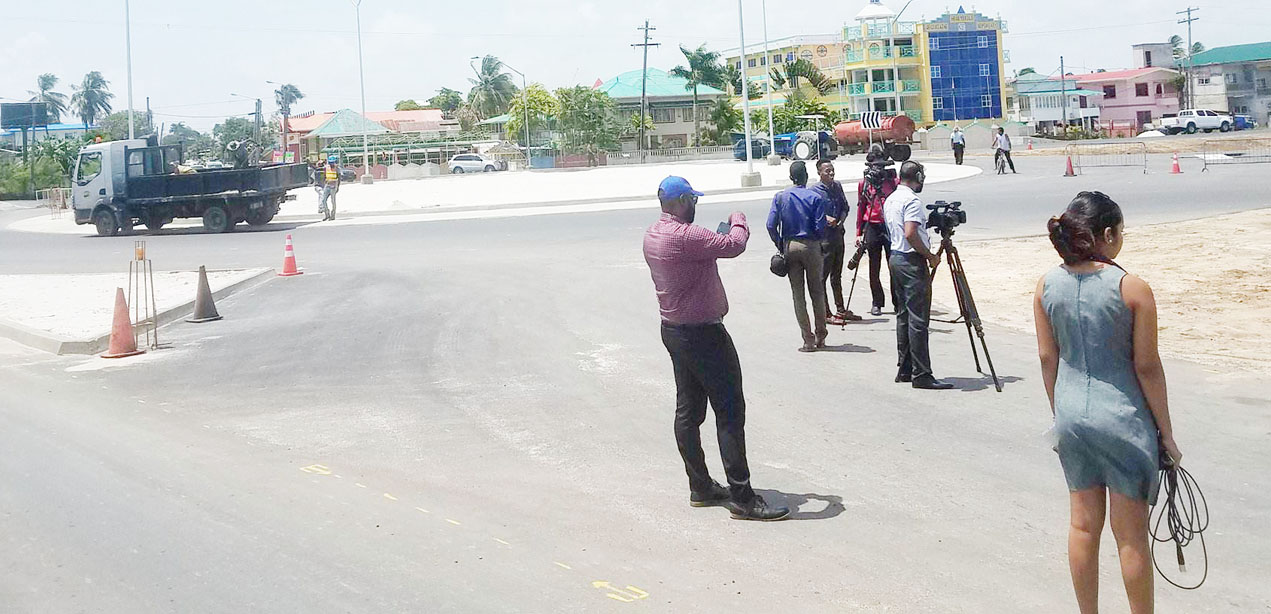The Kitty roundabout is nearly complete and set to be fully open to motorists before Independence Day.
At a press conference held yesterday at the Ministry of Public Infrastructure’s head office, members of the media were told that the roundabout, constructed at the intersections of the Seawall Road, Rupert Craig Highway, Kitty Public Road, Vlissengen Road, JB Lachmansingh Road and Carifesta Avenue, is projected to be open before May 26.
WATCH
Senior engineer at the Ministry, Sherod Parkinson, stated that although the roundabout is a new feature, there are core principles of driving that still apply. Parkinson also praised the contractor for their performance on the project, as it relates to starting work on time and completing the project a month and a half before schedule. Parkinson also stated that by next week they would be able to give a date for the official opening of the roundabout.
All that is needed for completion of the project, which was said to be about 95-98% finished, is the placement of road markings and the installation of traffic lights.
The traffic lights will control traffic coming from the JB Lachmansingh Road and the Kitty Public Road. The roundabout will be opened as the road markings are completed.
“We intend to open it without the actual installation of the two traffic lights, because it takes some time for the traffic lights to get into the country and for the installation of them. Really and truly, a roundabout is supposed to function without a traffic light so we intend to open without the traffic lights, see if it can function with the volume of traffic at peak hours. If it is still required, we will then put the traffic lights in place to manage the traffic at peak hours,” Parkinson related.
Project engineer, Jorge Linton, yesterday described the correct way to use the roundabout. Linton stated that the speed limit within the roundabout will be 30 kilometers per hour and related that traffic will only be allowed to flow clockwise.
“Vehicles entering the roundabout have to yield to persons within the circulatory lane. There is no overtaking in the roundabout. It is very important that you choose your lane correctly before you enter the roundabout, because switching lanes is prohibited,” he explained.
Members of the media were also taken to the site and given a live demonstration of the way the roundabout should be used.
Media operatives were stationed on the island of the roundabout, while an engineer used the ministry’s vehicle to demonstrate the correct ways to use the roundabout at all entry, exit and bypass roads. As the vehicle was being driven, its movements were explained by Linton.
The vehicle first entered the roundabout from Seawall Road, proceeded on to the inner circulatory lane and exited onto Vlissengen Road. The vehicle reentered the roundabout using the JB Lachmansingh Road, proceeded onto the outer lane of the roundabout, and exited on the Rupert Craig Highway.
Zebra crossings will be placed at all entry and exit points for the roundabout. Pedestrians are prohibited from crossing anywhere within the circulatory island, however, cyclists have the options of either using the roundabout as a pedestrian, by dismounting the bicycle or using the zebra crossing, or they can use the roundabout as a motorist.
Correct ways to use the roundabout will be displayed on the Ministry of Public Infrastructure’s website and posted in various media outlets.
Earlier in the year a $78.9 million contract was awarded to S. Jagmohan Hardware Supplies and Construction Services for works on the roundabout.










